As a pro golfer myself, I can attest to the importance of keeping your golf clubs clean and well-maintained. Not only does regular cleaning help preserve the performance and longevity of your clubs, but it can also enhance your overall golfing experience.
So, let’s dive into the steps of cleaning your golf clubs:
Step 1: Gather your cleaning supplies
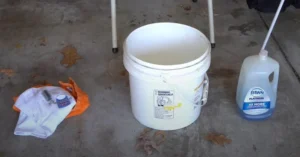
To clean your golf clubs effectively, you’ll need a few simple items: a bucket or sink, warm water, mild dish soap, a soft-bristle brush (toothbrushes work well), a towel, and a tee or small wooden dowel.
Step 2: Prepare the cleaning solution
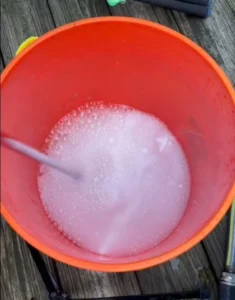
Fill your bucket or sink with warm water. Add a small amount of mild dish soap and mix it gently to create a soapy solution. Avoid using harsh detergents or abrasive cleaners, as they can damage the club’s finish.
Step 3: Submerge the clubheads
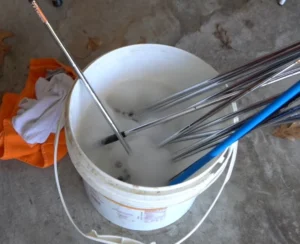
Take each golf club and immerse the clubheads into the soapy water. It’s essential to keep the clubheads submerged while cleaning to ensure the dirt and grime loosen up.
Step 4: Scrub the clubheads
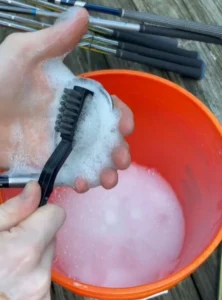
Using the soft-bristle brush or toothbrush, gently scrub the clubheads, paying close attention to the grooves on the face. This step helps remove dirt, grass, and debris that can accumulate during your rounds of golf. Take your time and be thorough, but avoid applying excessive pressure to prevent scratching the clubface.
Step 5: Clean the club grips
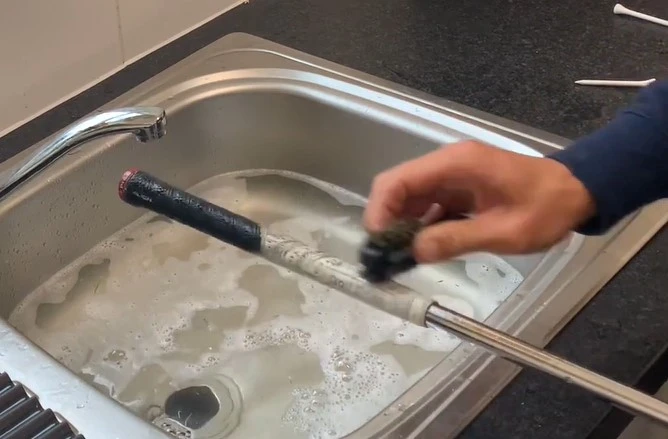
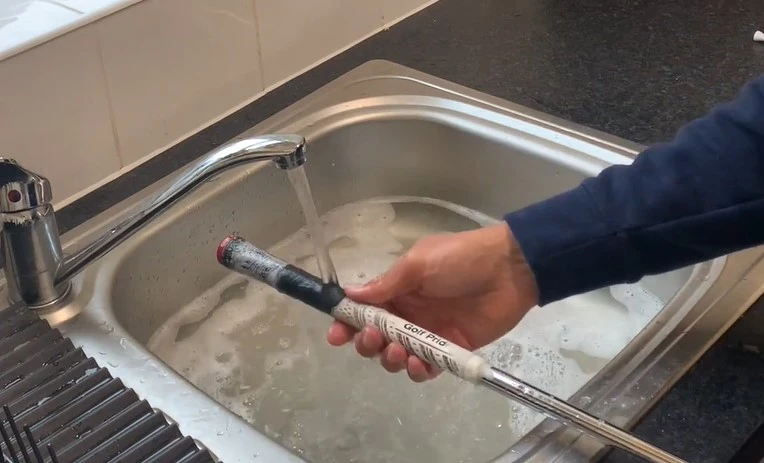
While the clubheads are soaking, you can take this opportunity to clean the grips. Wet a towel with the soapy water solution and wipe down each grip, removing any dirt or sweat buildup. Rinse the grips with clean water and pat them dry with a towel.
Step 6: Rinse the clubheads
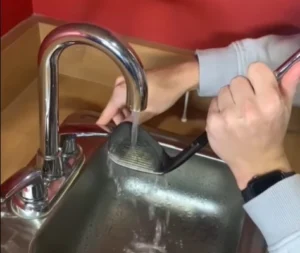
Once you’ve scrubbed the clubheads, remove them from the soapy water and rinse them thoroughly under warm, running water. Ensure that all soap residue is washed away. Be cautious not to wet the shafts excessively, as excessive moisture can seep into the clubheads and shafts.
Step 7: Dry the clubs
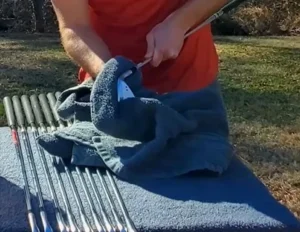
Using a towel, gently dry the clubheads, paying attention to the grooves. You can also use a tee or a small wooden dowel to remove any remaining dirt or debris from the grooves. Wipe the shafts and grips dry with the towel as well.
Step 8: Final touches
After the clubs have dried, inspect them closely for any stubborn dirt spots or residue. If needed, you can use a little rubbing alcohol on a cloth to remove any persistent stains. Ensure that the clubheads, shafts, and grips are completely dry before storing them.
Step 9: Store the clubs properly

To keep your golf clubs in optimal condition, store them in a cool, dry place, preferably with headcovers on the woods and putters. This will protect them from dust, moisture, and potential damage.
This video will show you how to clean your golf clubs with soapy water and a brush.
How often should I clean my golf clubs?
Ideally, you should clean your golf clubs after every round of golf or at least once every few rounds. Regular cleaning helps maintain the performance and longevity of your clubs. It prevents dirt, grass, and debris from accumulating on the clubheads and in the grooves, which can affect your ability to make clean contact with the ball.
Cleaning your clubs after each round also allows you to inspect them closely for any signs of damage or wear. This way, you can address any issues promptly and ensure that your clubs are in optimal condition for your next game.
However, if you find it challenging to clean your clubs after every round, try to establish a routine where you clean them at least once a month during the golf season. This frequency will help prevent excessive buildup and maintain the overall quality of your clubs.
Remember, keeping your clubs clean is not only about appearance but also about performance. So, make it a habit to clean them regularly to maximize your enjoyment on the course and to protect your investment in your golf clubs.
Is there a specific technique for cleaning the grooves on the clubface?
Yes, cleaning the grooves on the clubface is a crucial step in maintaining the performance of your golf clubs. The grooves play a significant role in generating spin and control on your shots, so it’s essential to keep them clean and free of debris.
Here’s a specific technique you can follow:
- After submerging the clubheads in the soapy water solution, take your soft-bristle brush or toothbrush and hold it at a slight angle to the grooves.
- Gently scrub the grooves back and forth using short, firm strokes. The bristles should go across the grooves, not parallel to them. This motion helps dislodge dirt, grass, and any other debris that may be trapped in the grooves.
- Pay extra attention to any stubborn or compacted dirt that may require a bit more effort to remove. You can apply slightly more pressure to these areas, but be careful not to damage the clubface.
- As you scrub, periodically rinse the clubheads under warm, running water to remove loosened dirt and debris. This will also allow you to assess your progress and identify any remaining areas that need further cleaning.
- After thoroughly cleaning the grooves, use a tee or a small wooden dowel to remove any remaining debris. Gently run the tee or dowel through each groove, ensuring that they are clear and free of obstructions.
- Once the grooves are clean, rinse the clubheads again under running water to remove any residue from the cleaning process.
- Finally, dry the clubheads thoroughly using a towel, making sure to remove any excess moisture from the grooves. It’s crucial to dry the grooves properly to prevent the buildup of rust or corrosion over time.
Can I use any household cleaning products to clean my golf clubs?
While it’s generally recommended to use mild dish soap and warm water for cleaning golf clubs, some household cleaning products may be suitable for specific situations. However, it’s crucial to exercise caution and ensure that the products you use won’t damage the clubheads, shafts, or grips. Here are a few considerations:
- Mild household cleaners: Certain mild household cleaners, such as all-purpose cleaners or gentle surface cleaners, may be safe to use on your golf clubs. However, always check the labels and ensure they are safe for use on the materials of your clubs. Avoid harsh chemicals or abrasive cleaners that can damage the club’s finish or strip off protective coatings.
- Rubbing alcohol: Rubbing alcohol can be used sparingly to remove persistent stains or sticky residue on the clubheads or grips. Apply a small amount of rubbing alcohol to a cloth and gently wipe the affected areas. However, limit its use and avoid excessive contact with club components.
- Vinegar: Vinegar is occasionally suggested for removing rust from golf clubheads. You can soak a cloth or toothbrush in vinegar and gently scrub the affected areas. Afterward, rinse the clubheads thoroughly and dry them completely to prevent further rusting. However, note that vinegar may have a strong odor and should not be used on non-metal parts of the clubs.
Are there any special considerations for cleaning forged or chrome-plated clubs versus stainless steel clubs?
Yes, there are some special considerations when cleaning forged or chrome-plated clubs compared to stainless steel clubs. Here’s what you need to know:
- Forged Clubs: Forged clubs have a softer metal composition, which provides a unique feel but also makes them more prone to scratching and denting. When cleaning forged clubs, it’s crucial to use a soft-bristle brush or toothbrush to avoid scratching the clubheads. Be gentle while scrubbing the clubface and grooves. Avoid using abrasive cleaners or harsh chemicals that can damage the club’s finish. Dry the clubs thoroughly after cleaning to prevent moisture from causing rust or corrosion.
- Chrome-Plated Clubs: Chrome-plated clubs have a thin layer of chrome applied to the clubheads, which gives them a shiny and attractive appearance. When cleaning chrome-plated clubs, it’s essential to be cautious not to scratch or damage the chrome finish. Use a soft-bristle brush or toothbrush to clean the clubheads and grooves gently. Avoid abrasive cleaners, harsh chemicals, or abrasive scrubbing pads that can scratch or dull the chrome plating. Dry the clubs thoroughly after cleaning to prevent water spots or tarnishing.
- Stainless Steel Clubs: Stainless steel clubs are generally more durable and resistant to scratching compared to forged or chrome-plated clubs. You can use a soft-bristle brush or toothbrush to clean the clubheads and grooves. Mild dish soap and warm water are generally safe to use. If needed, you can be slightly more aggressive with cleaning stainless steel clubs, but still avoid abrasive cleaners or harsh chemicals that can damage the finish. Dry the clubs thoroughly after cleaning to prevent water spots or corrosion.
Conclusion
Keeping your golf clubs clean is essential for maintaining their performance, longevity, and appearance. Regular cleaning not only removes dirt and debris but also allows you to inspect your clubs for any signs of damage or wear. By following the steps outlined in this guide, you can effectively clean your golf clubs and ensure they are in optimal condition for your next round on the course.
Hi! I am Hannah, a golf enthusiast, have been perfecting my swing for over a decade, making long putts a breeze. Aside from playing, I am a professional golf writer, I try capture the nuances of the game and inspire others to embrace their love for golf. Follow me on Twitter.

